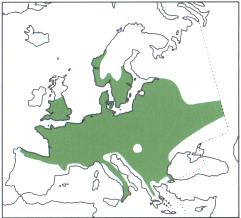Marsh Tit - Parus Palustris
Source: British Garden Birds (www.garden-birds.co.uk)
| Length | 12 cm |
| Weight: | 10-12 g |
| Present: | All Year |
| Wing Span: | 18-19 cm |
| Breeding Pairs in Great Brittan: | 60 000 |
| Status: | Red List |
 Description
Description
The Marsh Tit and the Willow Tit are difficult to
tell apart as both have black caps, sandy-brown upper parts, and buff underparts. Indeed,
the two were only recognised as separate species at the turn of the last century.
The Marsh Tit is less scruffy looking than the Willow Tit and has a neater, smaller bib
and glossier black cap. Also, the Marsh Tit lacks the pale wing panel, does not look
"bull-necked", and has a square-ended tail.
The Coal Tit is similar, but has a white patch on the
nape and a much larger bib. The Blackcap is bigger and does not have a bib.
A more reliable method of differentiating the two species is by their calls.
The Marsh Tit call sounds like a ringing sneeze, "pitchoo". Their song is mostly
based around this call.
Feeding
Marsh Tits feed on the ground more than most tits, feeding on insects and seeds, such
as beech mast.
Peanuts, seeds, and fat may attract them to gardens, but usually only if there are ancient
woodlands nearby (contrary to their name, they do not live in marsh land).
Breeding
The female builds the nest, which is a cup of moss lined with feathers and hair, in a
hole in a tree. They usually nest in deciduous trees, like willows or alders, but will
sometimes use a box.
The Marsh Tit's eggs are smooth and glossy, and white with brown markings. The female
incubates the eggs by herself. After the young hatch, they are fed by both parents.
| Breeding Starts | Number of Clutches | Number of Eggs | Incubation (days) | Fledge (days) |
| mid-April | 1-2 | 5-11 | 13-17 | 16-21 |
Distribution

Comments
The Marsh Tit is a Red List species owing to a large, rapid decline in the breeding population over the last 25 years.
[ Home ] [ Bird overview ]